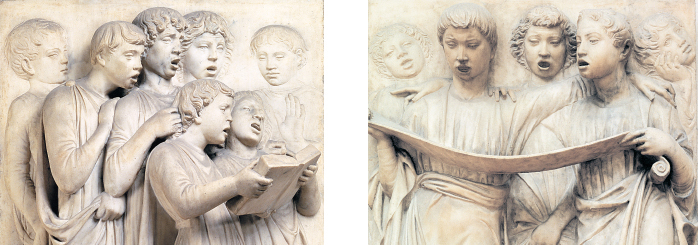1 | New Attitudes

Compare two Madonnas shown in this book: One (page 43) is a late medieval masterpiece from northern Europe, the other from the new world of Renaissance Italy (page 36; painted only fifty years later). Uncrowned, uncluttered, the mother here smiles, the children play — God and His angels do not encircle this Madonna by Raphael as they do Lochner’s on page 43. Mondadori Portfolio/Electa/Sergio Anelli/The Bridgeman Art Library.
A good indication of the Renaissance mind-set, in the early fifteenth century, was a new way of treating plainchant in polyphonic compositions. Medieval composers writing organum or isorhythmic motets seem to have felt that so long as they used a traditional plainchant, there was nothing wrong with distorting it. They lengthened its notes enormously underneath the added counterpoints. They recast the meterless chant into fixed, arbitrary rhythms.
Renaissance composers no longer felt obliged always to use plainchants; but when they did, they tended to treat them as melodies to listen to, not as scaffolding for polyphonic structures. They embellished chants with extra notes, set them in graceful rhythms, and smoothed out passages that struck them as awkward or old-fashioned. This procedure is known as paraphrase.

The church singers in these famous panels by Florentine sculptor Luca della Robbia (1400–1482) are handsome boys who seem to be taking the same sensuous pleasure in their singing as Luca did in sculpting them. Both images: Scala/Art Resource.
Renaissance composers using paraphrase emphasized the sonorous, sensuous aspect of the chant rather than its function as structure and control — its authoritarian function, one might say. (Sonority means either tone color or, more loosely, rich tone color.) A new sensitivity to sonority and melody was one of the first signs of Renaissance attitudes toward music.
Having transformed plainchants into modern melodies with a more attractive profile, composers put them not at the bottom of the polyphony but on top, in the soprano, where they could be heard most clearly.

